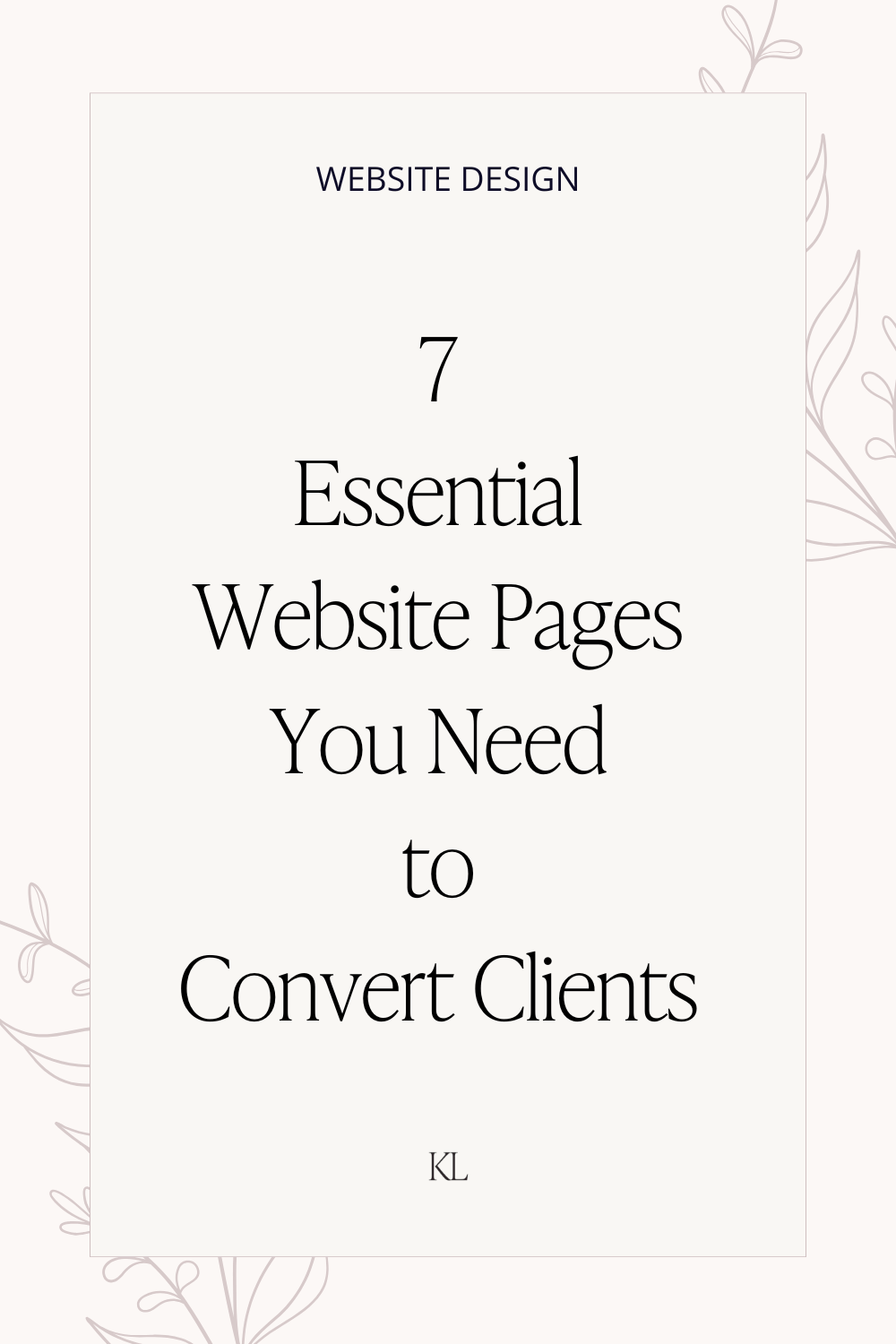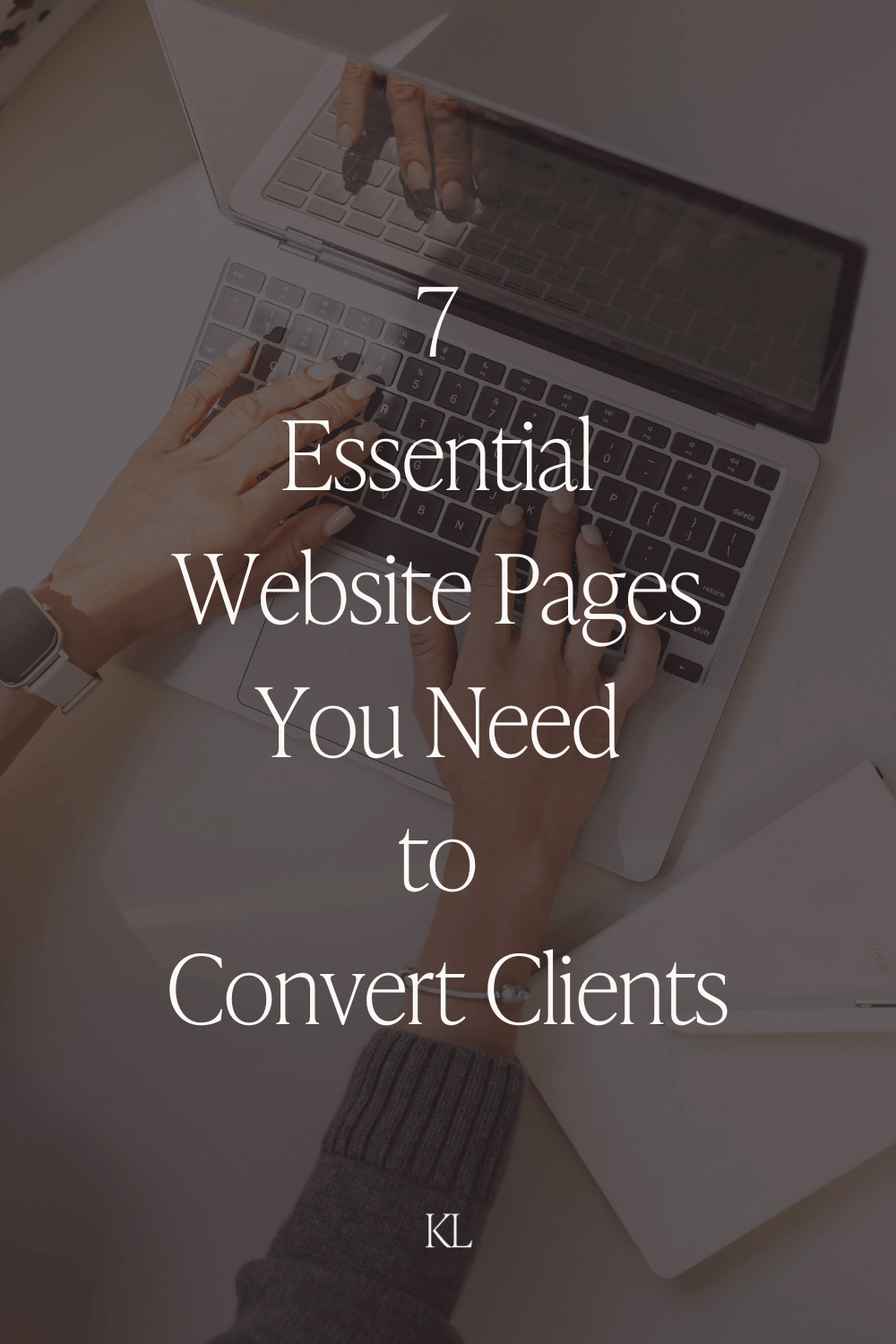7 Essential Website Pages You Need to Convert Clients
*Disclosure - this post contains some affiliate links. This means that if you click on my link and then go on to make a purchase, I will receive a small amount of commission at no additional cost to you.
Building a website for your business is a really exciting time. But it can also be daunting if you don’t know exactly what information you need to put on your website, or how you should organise the information in a way that is logical but also gives your ideal clients the exact information they need in order to book with you.
There are 7 essential website pages every business needs in order for the website to be successful and present the information in the best way possible.
It is best to get all your copy, images, videos and any other content you need ready before you start building your website.
The 7 essential website pages every website needs
Homepage
Not everybody will enter your website via the homepage, but for most website visitors this is the first page that they will see. This page has to grab the visitor’s attention so it has to look good enough for your visitors to want to find out more about your business. If your homepage looks outdated or too cluttered, it will put potential clients off.
The information you put on your homepage is equally important as how it looks. Website visitors decide in seconds whether the website they are looking at is the right place for them, so ensure your copy is clear, concise and logically laid out. Any calls to action (CTAs) should be obvious, especially how to contact you.
Here is a list of things you should include on your homepage:
A headline and subheading that outlines what you do and who for
Explanation of your services
Links to service pages
CTA to contact you
Social proof e.g. testimonials or reviews
Any other content that sparks interest or strengthens your message
You can plan the content for your homepage using this Homepage Workbook to ensure you don’t miss anything crucial.
2. About Page
This page is an opportunity for you to connect with your website visitors. Instead of listing your work history or writing about your personality, write about your brand story and values. Tell your visitors what makes you different from your competitors. Let your visitors know what you can do for them and what qualifies you to do it. Speak to your ideal customer’s pain points and let them know that your service is the solution.
Use this page as an opportunity to let your visitors know that there is a human behind the brand by adding some photos of yourself and team members if relevant. People will always want an idea of who they will be doing business with so this is the first step to breaking down any barriers.
Don’t forget to include a CTA at the bottom of this page so it’s easy for visitors to get in touch with you if they want to.
3. Services or Digital Product Pages
Your services page should outline your service packages and give a starting price for each of your packages. You can include details about what is included in each package as well as any add ons that you offer.
I recommend linking out to individual pages for each service package. Use the individual pages to go into more depth about each package, including the benefits to the client, the process and any unique selling points that separate you from others in your industry. This way you are not cramming all the content into one Services page, but giving people the option to find out more if they want to. Ensure that the links to these additional pages are clearly marked to encourage click throughs.
If you sell a lot of digital products, the same idea applies. Build a page that outlines your product offerings and link out to additional pages that go into more detail about each product. You do not necessarily need a separate page for each product. You can bundle all your courses together on one page and all your templates together on another page, but ensure that these additional pages are easy to navigate and that each product is clearly separated from the others on the page.
4. Blog
Blogging on your website is one of the best things you can do to establish authority in your industry, build trust with potential customers and grow your email list. Blogging is also great for SEO, and when done consistently, will help your website be found organically on search engines.
Instead of using your blog to hard sell your services or products, use your blog to educate your audience on your process, sharing case studies, reviewing products or platforms that are relevant to your audience and share “how to…” posts to position yourself as the expert.
Remember to add a CTA at the bottom of each blog post. E.g. download the free checklist.
Read my guide on The Benefits of Blogging for Long Term Business Growth.
5. Contact
As a business owner, there is nothing more important than having someone reach out to you because they want to pay you for your services. Adding a dedicated contact page to your website will stop your website visitors from having to search for your contact information on the other pages. At the very least your contact page should have the following information:
Email address
Business hours
Physical address (if applicable)
You could include a form on your contact page to capture any necessary information you need from a lead, but remember to keep this form short. Avoid asking any unnecessary questions as that may put potential clients off.
If your physical location is relevant to your clients, you can include a map as well as the address details. Any potential clients who will need to visit you in person will need to know if they can actually get to you, so adding a map is helpful information for them.
If you are happy for people to book in for a call directly, you can add a link to your Acuity Scheduler or Calendly so your future customers can choose a time that works for them.
6. Privacy Policy
A Privacy Policy informs your website visitors how you plan to use the personal information that you get from them. If you plan on using people’s personal information for marketing, to email them, to retarget them etc. then you need to tell them that this is what you will be doing.
The Contract Shop* sells a Privacy Policy template with an in depth video tutorial on how you can customise it for your business and your website. This is an affordable way to get a Privacy Policy up and ready for your website. You could have a solicitor look over it to ensure nothing has been missed.
This is not legal advice. Please contact a legal professional for legal advice about your website.
7. Terms and Conditions
The Terms and Conditions of your website outline what people can and cannot do with, or on, your website. It helps to protect the rights to your website content.
The Contract Shop* also sells Terms and Conditions templates (usually in a bundle with the Privacy Policy template), along with a video tutorial that goes through how you can customise the document for your own needs. This is again, an affordable way to get Terms and Conditions up on your website and you can always have a solicitor look over it to ensure you’re covered.
This is not legal advice. Please contact a legal professional for legal advice about your website.
More Website Pages that Will Help You Convert Clients
Custom 404 error page
The 404 page is what website visitors land on if they click on a broken link. Best practice is to fix broken links as soon as possible, however, it is likely that someone will end up on your 404 page at some point.
The standard 404 page on Squarespace doesn’t have any functionality to guide anyone that lands on it back into your website, or to entice anyone to actually stay on your website.
By creating a custom 404 error page, you will be able to put in links to blog posts, your freebie or your services page to guide your audience back to relevant content.
Portfolio page
A portfolio page may not be relevant for every industry, but if it’s relevant to your industry then it’s a good idea to include one. Showcasing previous work that you’ve done for clients goes a long way to establishing your expertise and building trust with your audience. Add in testimonials from past clients on this page too to further build trust.
Landing and Thank You Pages
Including landing (opt-in) and thank you pages on your website will help you grow your email list. A lot of your website visitors may not be ready to take the leap and book your services right away, but if you give them an opportunity to sign up for your email list, you can email them regularly and stay top of mind for when they are ready for your service.
Create a lead magnet to entice your website visitors to sign up for your email list. By offering them something valuable in exchange for their email address, it gives them a taste of what it will be like to work with you and they are more likely to come back and pay for your service if your lead magnet helped solve a problem for them.
FAQs page
Including an FAQs page can go a long way to breaking down any barriers that your future clients have to actually booking your service. Include questions and answers about:
The services you offer
Your process
Pricing plans
Common misconceptions about your industry
The 7 Essential Website Pages Every Website Needs - The Bottom Line
In order for a website to be successful in generating leads for your business, the information you put on the website needs to be optimised in a way that is both visually appealing and logical. Separating your website content across the 7 essential website pages will not only give your potential clients the information they need, but by using every page as an opportunity to guide your website visitors towards a specific action, you will receive inbound leads.
Start planning your website content today with this Homepage Workbook. It guides you through how to lay out your homepage so that it is logical and easy to navigate for anyone who lands on your website. You can download it here.
↓ Liked this post? Pin it to Pinterest ↓



